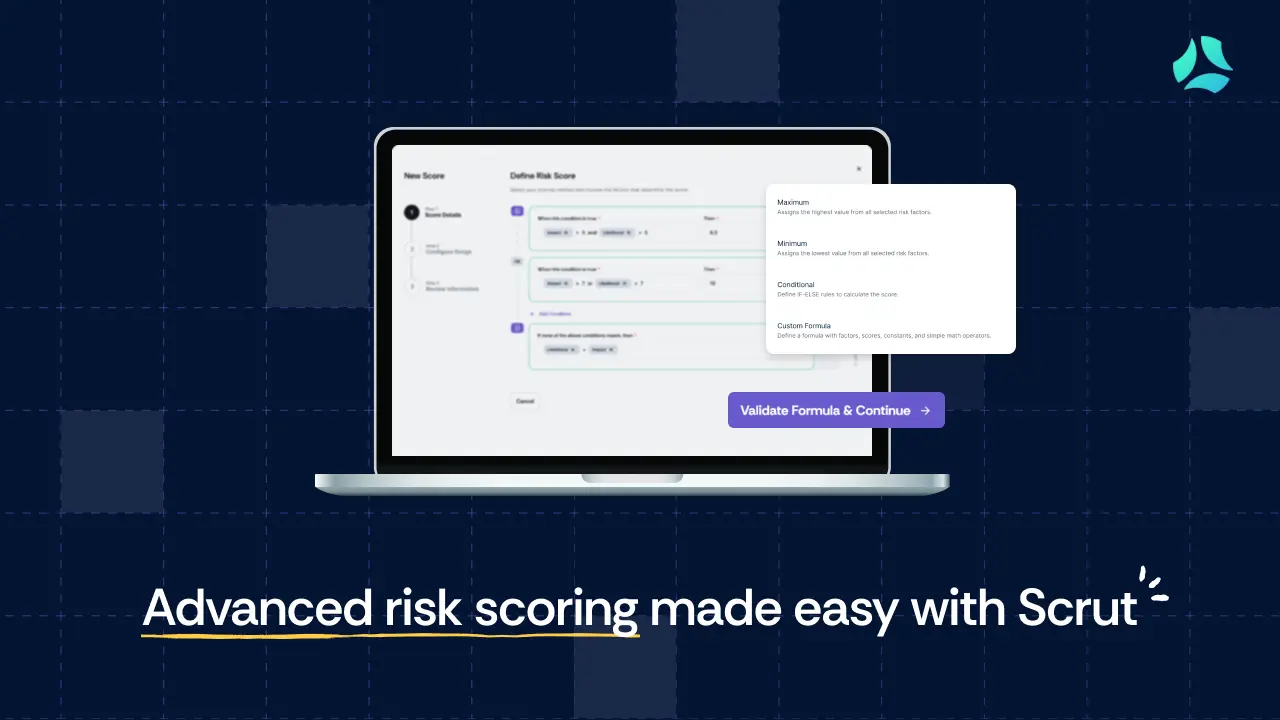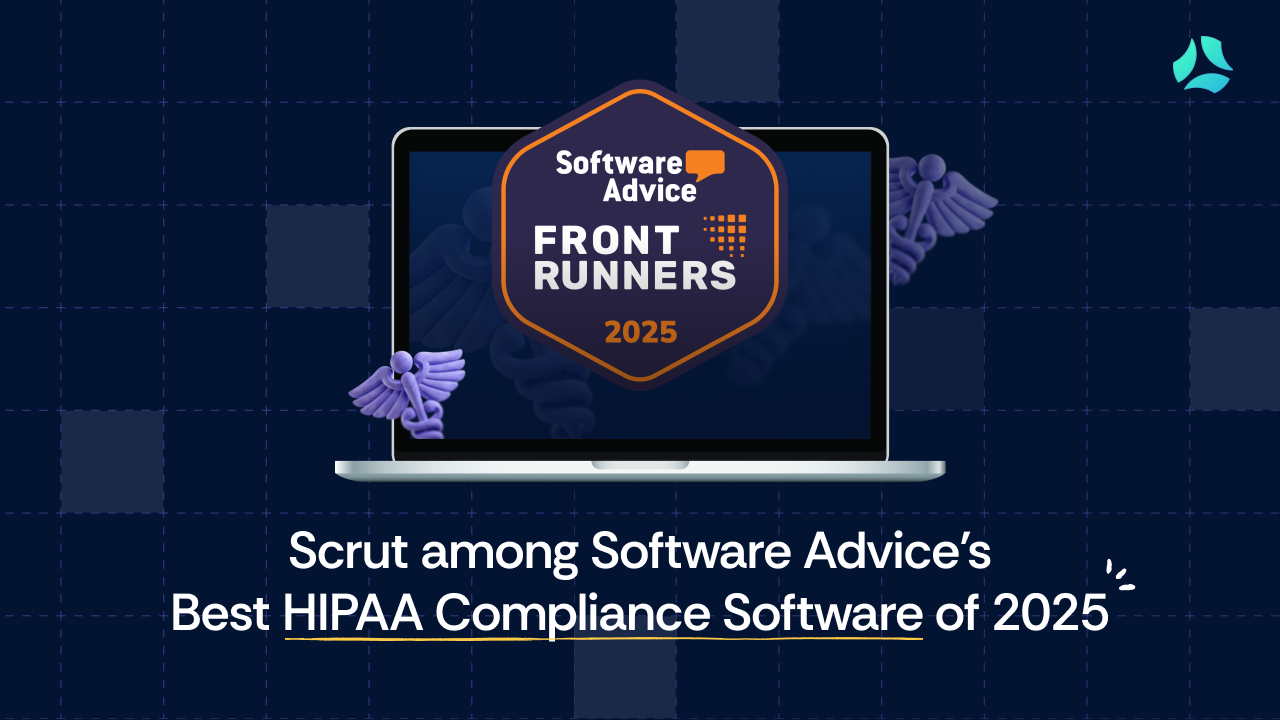How to conduct an effective compliance risk assessment in 2025
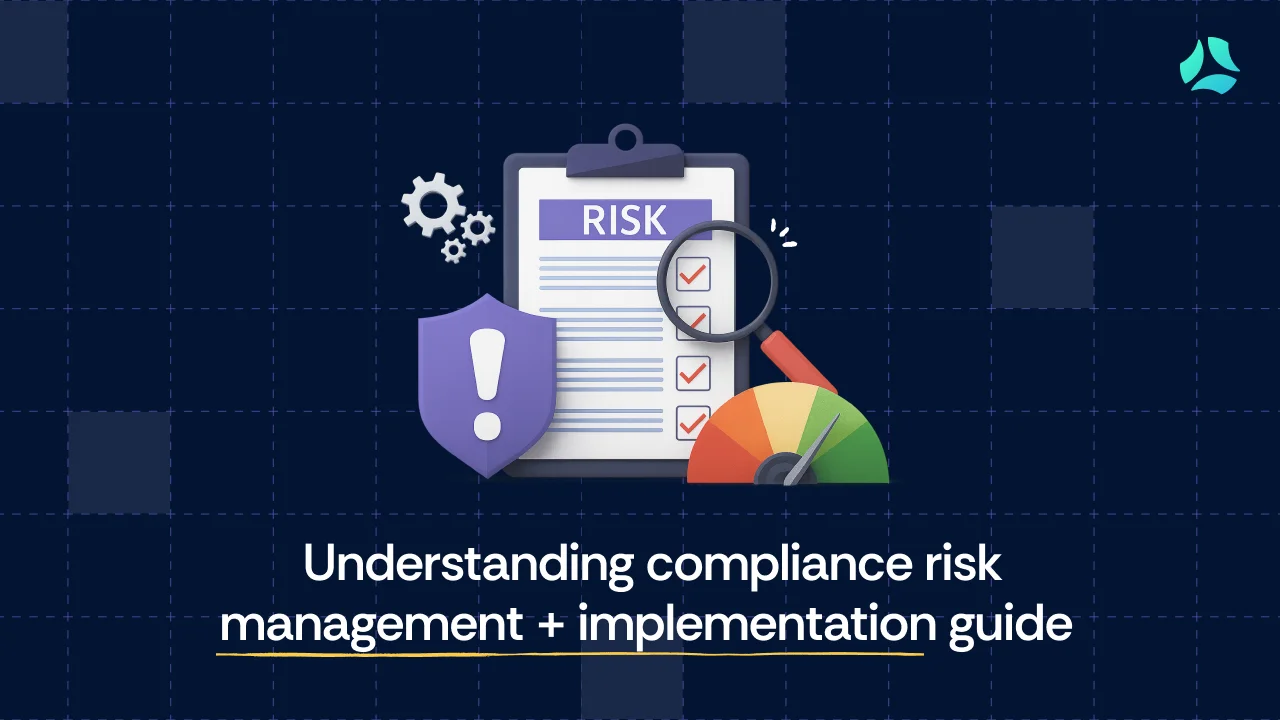
With new rules around data privacy, ESG, and workplace safety constantly emerging, business leaders need a clear way to prioritize compliance risks and focus resources where they matter most.
Ignoring this can mean costly fines, operational disruption, and damage your reputation. This article breaks down key compliance risks and offers straightforward best practices and actionable steps to help you conduct an effective compliance risk assessment—and build a stronger, more resilient compliance program.
What is compliance risk?
Compliance risk refers to the potential financial, legal, or reputational damage resulting from a company’s failure to comply with external regulations, industry standards, or its own internal policies. Companies can also be liable for violations by external vendors or third parties, depending on the industry and applicable regulations.
These risks can arise from non-compliance with labor laws, data protection rules, corporate governance standards, or industry-specific regulations. Left unmanaged, compliance risks can lead to regulatory actions, hefty fines, business disruptions, lawsuits, and loss of stakeholder trust.
Examples of compliance risks
Compliance risks can take many forms—shaped by your industry, business model, regulatory environment, and internal governance standards. Real-world examples reveal just how high the stakes are and highlight why proactive compliance isn’t optional.
1. Regulatory
These arise when an organization fails to meet the legal or industry-specific standards set by regulatory bodies. Common regulations include general data protection laws [the EU’s General Data Protection Regulation (GDPR)], the Sarbanes-Oxley Act (SOX) for publicly traded companies across industries in the United States (US), or sector-specific regulations such as the Health Insurance Portability and Accountability Act (HIPAA) for healthcare.
For example, since GDPR came into effect in 2018, the most significant share of penalties have been due to violations of general data processing principles—amounting to over €2.4 billion in fines.

In August 2024, the Dutch Data Protection Authority (DPA) imposed a fine of €290 million on Uber for transferring sensitive data of European drivers to U.S. servers without adequate safeguards.
2. Operational
These stem from failures in internal processes, weak controls, or human error. Poor documentation, outdated procedures, lack of training, or intentional misconduct can all open the door to compliance failures.
In November 2023, cryptocurrency exchange Binance was fined over $4 billion for failing to maintain effective anti-money laundering (AML) programs, with internal breakdowns in Know Your Customer (KYC) procedures at the core of the issue.
3. Cybersecurity
Evaluating cybersecurity posture is a critical part of any compliance risk assessment, as protecting sensitive data is foundational to meeting data protection laws.
A breach caused by poor access controls, outdated systems, or employee negligence can lead to data loss, legal penalties, and long-term reputational damage. In 2024, the average global cost of a data breach rose 10% to $4.88 million.
A strong compliance risk assessment helps identify whether your cybersecurity practices meet both internal security policies and global standards such as ISO 27001.
4. Environmental, social, and governance (ESG)
ESG compliance risks are becoming more prominent as regulations and stakeholder expectations evolve. These risks can lead to substantial legal, financial, and reputational fallout if ESG obligations are ignored or misrepresented.
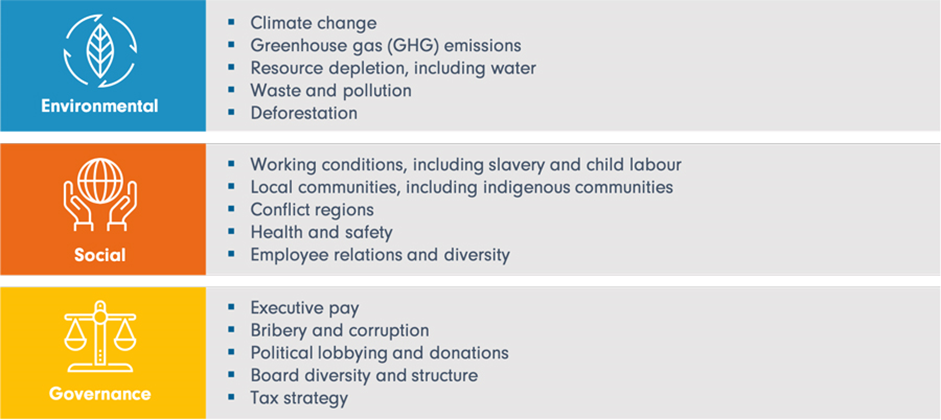
In the EU, companies can face fines of up to 5% of their net global turnover for failing to comply with ESG mandates, even as implementation is at the national level, with individual countries setting their own standards. The consequences are increasingly visible:
Snapchat paid $15 million to settle workplace sexual harassment and discrimination claims.
These examples reinforce why ESG compliance risks must be incorporated into compliance risk assessments—not just to avoid penalties, but to build trust and future-proof your operations.
Compliance risk assessment best practices
Businesses need systems that proactively identify, assess, and mitigate compliance risks. These best practices enable that transformation:
1. Assemble a cross-functional team
An effective compliance risk assessment doesn’t happen in a silo. Bring together experts from various departments —legal, HR, finance, IT, and operations—to gain a comprehensive view of potential risks. Each function offers a unique lens into potential vulnerabilities, and together they conduct a more holistic compliance risk assessment.
2. Develop targeted risk mitigation strategies
A structured evaluation method—like a risk matrix—helps separate the urgent from the noise. Use it to score risks based on their likelihood and potential impact. Then, act decisively: implement new controls, update policies, and ensure teams are trained on what matters most.
Assess existing policies, procedures, and monitoring tools to determine if they’re adequate for an evolving risk landscape.
3. Maintain an updated risk register
As compliance risks evolve, use real-time monitoring to ensure controls remain effective. Static risk registers quickly become outdated. Ensure your risk inventory reflects current threats. And make sure every risk is mapped to relevant frameworks and controls.
4. Document and communicate findings
Don’t bury risk findings in spreadsheets. Turn them into actionable insights for leadership. Clear documentation—summarizing threats, decisions, and next steps—keeps compliance aligned with business strategy and helps build stakeholder trust.
5. Leverage advanced technology solutions
Manual compliance doesn’t scale. Leverage AI, machine learning, and cloud platforms like Scrut to automate evidence gathering, maintain audit trails, and reduce errors. These tools not only improve efficiency but also strengthen your organization’s resilience.
6. Third-party / vendor risk assessment
Assess third-party / vendor compliance with relevant laws and regulations, such as data protection. Conduct due diligence, monitor performance, and include contractual safeguards, as inadequate oversight can lead to fines or regulatory actions.
7. Incident response planning
A well-defined incident response plan minimizes risks by ensuring organizations are prepared to manage breaches, such as data leaks or other regulatory violations. It enables you to demonstrate responsibility and accountability to regulators and avoid costly fines through timely interventions.
8. Regulatory expectations for board involvement
Regulators expect boards to play an active role in overseeing compliance risk and ensure the organization complies with all applicable laws and regulations. The board should provide adequate oversight and guidance on regulatory matters.
9. Monitor and review continuously
The compliance landscape constantly evolves, with new regulations and emerging threats. Reassess risks periodically, especially after regulatory changes, business expansion, or incidents.
Key steps for a successful compliance risk assessment in 2025
A successful compliance risk assessment takes a structured, proactive approach—identifying, evaluating, and mitigating risks tied to regulatory, legal, and policy obligations. Regular compliance risk assessments aren’t just best practice—they’re essential for spotting potential issues early and staying ahead of evolving standards and regulations.
1. Define scope and regulatory obligations
Begin by defining the scope and what the compliance risk assessment will cover. Once scoped, identify the business units, processes, and geographies to be covered in the assessment.
Next, list all relevant laws, industry regulations, internal policies, and ethical standards that the organization must comply with (e.g. SOX, HIPAA, ESG requirements, etc).
2. Identify and categorize risks
Engage stakeholders across departments to gather insights on processes and pain points and identify and evaluate potential risks. Analytical tools such as risk maps, process flows, user interviews, and audits can help you systematically identify and visualize compliance risks.
Also, perform regular audits and reviews of compliance processes and controls to uncover hidden risks and ensure the effectiveness of existing controls. Track changes in relevant laws and regulations and update the compliance framework, which will help you proactively identify new risks.
Once identified, classify risks by category—legal, operational, reputational, cybersecurity—and align them with relevant compliance domains such as data privacy, anti-corruption, or workplace safety. From there, map them to appropriate frameworks, such as ISO 27001, SOC 2, or HIPAA, for a clearer picture of where you stand.
3. Analyze risk impact and likelihood
Not all risks are created equal. Some might be rare but catastrophic; others frequent but low-impact. Use a scoring system or risk matrix to classify them—and spotlight the ones needing immediate attention.
4. Map risks to controls and mitigation strategies
Effective risk mapping means connecting potential threats to the internal safeguards (controls) and mitigation strategies designed to address them. It’s how organizations understand their risk profile, identify gaps in their control framework, and pinpoint what needs immediate attention. The goal isn’t to cover everything—it’s to cover what matters most. This means ensuring that every key risk is tied to the appropriate controls and response plans.
5. Prioritize and document risks
Document all identified risks, assessment criteria, and mitigation plans in a structured format, such as a risk register. A well-documented compliance risk assessment plan outlines the risk analysis method, likelihood and impact ratings, responsible parties, and timelines.
Proper documentation and reporting support compliance with regulatory requirements, facilitate stakeholder communication, and enable ongoing risk monitoring and review.
6. Continuously monitor and update risk profiles
Periodically perform compliance risk assessments to evaluate your organization's risk posture as compliance risks evolve over time. To get started, keep a schedule for monitoring, reassessment, and updates to your risk management plan. Do this specifically when regulations or business models change.
Common pitfalls to avoid in compliance risk assessment
Even the most well-meaning compliance risk assessments can fall short if they overlook a few recurring pitfalls. Avoiding these missteps is critical to building a resilient and forward-looking compliance program.
1. Treating compliance risk assessment as a one-time activity
The compliance landscape doesn’t stand still. Regulations shift, operations expand, and new threats emerge constantly. Yet many organizations treat compliance risk assessment like a checkbox exercise—static and infrequent. This approach results in outdated risk profiles, missed red flags, and unnecessary exposure.
Instead, build in regular reviews, real-time monitoring, and consistent updates. Continuous assessment is what keeps your compliance posture responsive, relevant, and effective.
2. Overlooking third-party/vendor risks
Vendors handle sensitive data, deliver critical services, and often represent your brand to the end customer.
If their compliance slips, you’re the one exposed.
Proactively assess vendor risks, audit contracts, and ensure that third parties adhere to the same regulatory standards you do. It’s the only way to ensure true end-to-end accountability.
3. Failing to link risks back to operational processes
Map identified risks to departments, business processes, or workflows where violations could occur. If there’s no proper link to operational processes, risk mitigation strategies will lack both focus and follow-through. Connecting risks to the day-to-day operations makes compliance real. It strengthens internal controls where they matter most—at the exact points where violations are most likely to occur.
4. Compliance with emerging AI regulations
As businesses integrate generative AI into their organization’s workflows and leverage it for regulatory compliance, they should ensure adequate guardrails are built for safe and responsible use of this evolving technology.
In 2025, AI compliance will be a challenge for businesses as they increasingly adopt generative AI and rush to comply with upcoming regulations, such as the EU AI Act and other countries specific rules.
5. Ignoring geopolitical risks
A major disruption in the supply chain occurred in the post-pandemic world with the Russia-Ukraine war in 2022, which continues to this day in 2025. Since then, conflicts in the Red Sea and South China Sea have further enhanced supply chain risks. Additionally, businesses should consider other geopolitical risks in 2025, such as US tariffs that have the potential to disrupt global trade.
How Scrut simplifies compliance risk assessment?
Organizations struggle with manual compliance risk assessments, leading to incomplete risk analysis and delays in audits. These delays also slow down certifications like ISO 27001. Scrut, a compliance and risk management platform, simplifies the process. Its automated workflows streamline risk identification, remediation planning, and control tracking. Here’s how it can help with your compliance risk assessment:
Centralized risk and compliance management
Scrut centralizes risk management, control monitoring, and audits, ensuring compliance with over 60 frameworks. A pre-built library contains 100+ policies mapped to popular industry frameworks like SOC 2, ISO 27001, and more, enabling you to start your infosec programs promptly. You can customize these policies using built-in inline editors to meet your unique business needs.
The platform’s collaborative workflow enhances teamwork among internal and external stakeholders, improving efficiency and reducing manual efforts and errors.
Built-in risk scoring and frameworks
Its built-in expert-vetted scoring methodologies help you quantify your risk profile. The automated tool enables you to assess the impact of your treatment plans with inherent and residual scores. It simplifies risk management and helps you easily understand your organization's risk exposure, identify significant risk areas, and mitigate these risks.
Real-time risk monitoring and continuous compliance
With Scrut, continuous compliance becomes a reality. Its real-time monitoring and reporting capabilities allow you to track compliance status at every stage—across infrastructure, applications, and frameworks.
The platform instantly detects deviations, flags risks, and strengthens policy enforcement. This constant oversight improves audit readiness and significantly reduces the chances of security incidents or data breaches.
Automated reporting for audits and board presentations
If you have relied on spreadsheets and ad hoc reporting, you would have definitely experienced errors, delays, and a lack of audit readiness.
Scrut’s automated compliance reporting solution changes that. Its extensive integration capabilities with third-party systems help you generate detailed, accurate reports on a set schedule. The dashboard and reports allow you to communicate real-time security posture and metrics to multiple stakeholders.
You can manage risks by visualizing critical risks, prioritizing them, and analyzing the efficiency of your mitigation strategies. You can track risks throughout their lifecycle and drill into specific issues—all from a unified platform.
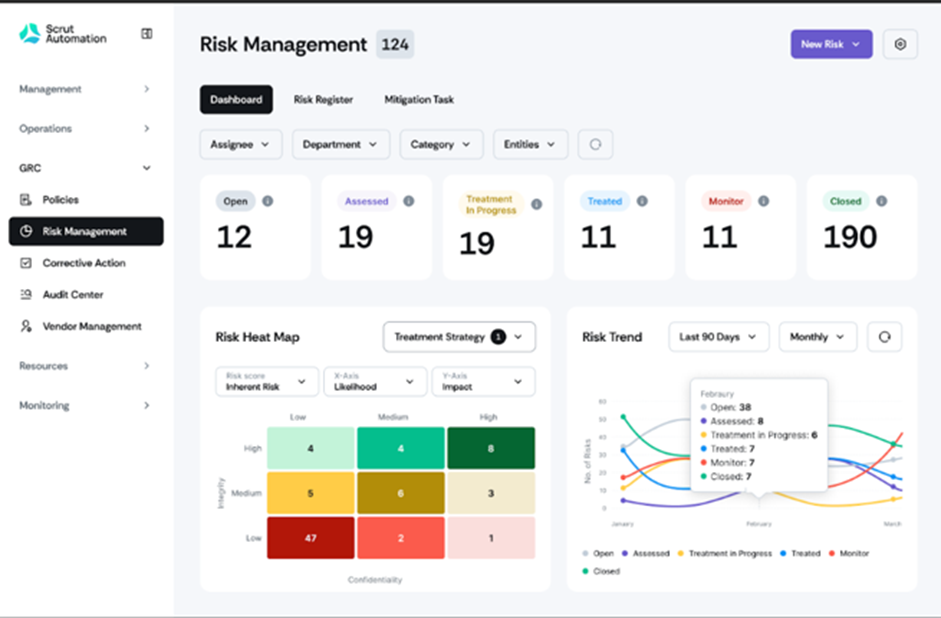
Conclusion
Automated compliance risk assessments help organizations centralize risk management activities—mapping standard-specific controls to risks, tracking compliance progress against each mitigated risk, and computing both inherent and residual risk.
Scrut Risk Management offers automated workflows to streamline risk assessments and execute treatment plans for remediation, acceptance, transference, or avoidance. Its dashboard visualizes risk assessment findings through heatmaps, trend analysis, and graphs. This improves visibility into your organization’s risk posture by dynamically updating risk scores as related risks or mitigation efforts change.
If you’re a startup or a small and medium enterprise (SME), you can use Scrut to replace spreadsheets and scattered workflows with a unified, intelligent platform. The platform helps you stay compliant across regulatory frameworks.
With built-in templates aligned with GDPR, auto-generated policy documents, data mapping tools, and real-time dashboards, Scrut helps you comply with GDPR without any missteps amid heightened regulatory scrutiny and enforcement. Additionally, Scrut lets you harness the potential of generative AI without compromising on governance and data security.
Ready to take control of compliance risk? Get started with your compliance risk management program and book your free risk assessment demo today.
FAQs
1. What is meant by compliance risk?
Compliance risk is the potential for legal, financial, or reputational loss resulting from a company's failure to adhere to regulations, industry standards, or internal policies.
2. What is an example of a compliance risk situation?
An example of a compliance risk situation is when a company's inadequate data protection measures lead to a customer data breach. The data breach results in regulatory agencies imposing fines on the company and causes reputational damage.
3. How to identify compliance risk?
Compliance risk is identified by assessing relevant regulations, industry standards, and internal policies. Organizations perform periodic audits and examine past violations to uncover areas of non-compliance.
4. What is an example of compliance?
An example of compliance is a healthcare organization following the Health Insurance Portability and Accountability Act (HIPAA) regulation. In compliance with the rules, the organization securely stores patient records, restricts data access, and trains staff to protect patient privacy and avoid legal penalties.
5. What is the biggest compliance risk?
Data breaches are considered to be the biggest compliance risk, as they can lead to significant regulatory fines, punitive action, and loss of customer trust.
6. What is the difference between regulatory risk and compliance risk?
Regulatory risk arises from changes in laws or regulations impacting a business. In contrast, compliance risk stems from failure to follow existing laws, regulations, or internal policies, which can lead to penalties or reputational harm.



